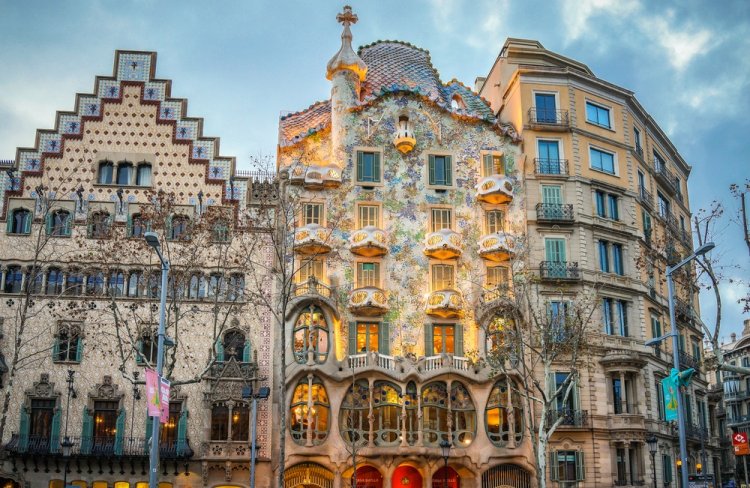Barcelona's Famous Architect: Unveiling the Genius of Antoni Gaudí
Barcelona, a vibrant metropolis brimming with art and culture, owes much of its unique architectural identity to one extraordinary visionary: Antoni Gaudí. This Catalan architect, whose innovative and nature-inspired designs continue to captivate and inspire millions, has left an indelible mark on the cityscape. From whimsical parks to awe-inspiring cathedrals, the works of Barcelona's famous architect Gaudí are instantly recognizable and stand as testaments to his unparalleled genius.
Share this Post to earn Money ( Upto ₹100 per 1000 Views )

Barcelona, a vibrant metropolis brimming with art and culture, owes much of its unique architectural identity to one extraordinary visionary: Antoni Gaudí. This Catalan architect, whose innovative and nature-inspired designs continue to captivate and inspire millions, has left an indelible mark on the cityscape. From whimsical parks to awe-inspiring cathedrals, the works of Barcelona's famous architect Gaudí are instantly recognizable and stand as testaments to his unparalleled genius. This article delves into the life, philosophy, and most iconic creations of this architectural luminary, offering a glimpse into the mind behind the magic.
The Life and Vision of Antoni Gaudí
Born in Reus, Catalonia, in 1852, Antoni Gaudí i Cornet displayed a keen interest in nature from a young age. This early fascination with the organic forms and intricate structures found in the natural world would profoundly influence his architectural style. He studied architecture in Barcelona, where he gradually developed his distinctive approach, moving away from traditional architectural norms towards a more personal and expressive language.
Gaudí's architectural philosophy was deeply rooted in Catalan Modernism, but he transcended the movement's typical aesthetics. He integrated elements of Gothic and Oriental styles, but his true innovation lay in his ability to synthesize these influences with his own organic and often whimsical vision. He meticulously studied natural forms, incorporating curved lines, irregular shapes, and textured surfaces into his designs. This biomimicry not only created visually stunning buildings but also contributed to their structural stability.
Iconic Masterpieces that Define Barcelona
The cityscape of Barcelona is dotted with architectural marvels conceived by Gaudí. Each structure tells a story, reflecting his unique vision and meticulous attention to detail. Here are some of his most famous works:
Sagrada Família: An Everlasting Testament
Perhaps Gaudí's most ambitious and iconic project, the Sagrada Família is a breathtaking basilica that has been under construction for over a century. Its towering spires, intricate facades depicting biblical scenes, and the forest-like interior showcase Gaudí's mastery of light, form, and symbolism. While still unfinished, the Sagrada Família attracts millions of visitors each year, drawn to its spiritual aura and architectural grandeur. Gaudí dedicated the latter part of his life almost entirely to this project, envisioning it as a "temple of light" that would inspire awe and devotion.
Park Güell: A Whimsical Urban Oasis
Located on Carmel Hill, Park Güell is a fantastical public park designed by Gaudí. Commissioned by Eusebi Güell, the park features vibrant mosaic-covered structures, serpentine benches offering panoramic city views, and whimsical pavilions that seem straight out of a fairy tale. The park beautifully integrates architecture with nature, creating a playful and enchanting environment. The iconic mosaic salamander, "El Drac," has become a symbol of Barcelona and Gaudí's imaginative spirit.
Casa Batlló: A Symphony of Organic Forms
Casa Batlló, a renovation of an existing building on Passeig de Gràcia, is a prime example of Gaudí's organic style. Its undulating facade, resembling bones and skulls (leading to its nickname "House of Bones"), is adorned with colorful mosaics and whimsical details. The interior is equally captivating, with flowing lines, stained glass windows, and innovative ventilation systems. Every element of Casa Batlló reflects Gaudí's meticulous attention to detail and his ability to transform a conventional building into a work of art.
Casa Milà (La Pedrera): Nature Carved in Stone
Another prominent landmark on Passeig de Gràcia, Casa Milà, also known as "La Pedrera" (The Stone Quarry), is characterized by its rugged, wave-like facade. Its seemingly random yet carefully calculated curves evoke the natural landscape. The rooftop, with its surreal chimneys and ventilation shafts resembling abstract sculptures, offers stunning views of the city. Inside, the building features innovative structural solutions and thoughtfully designed living spaces that reflect Gaudí's holistic approach to architecture.
The Enduring Legacy of Gaudí
Antoni Gaudí's untimely death in 1926 left a void in the architectural world, but his legacy continues to inspire and influence architects and artists globally. His unique style, characterized by organic forms, vibrant colors, and meticulous craftsmanship, remains instantly recognizable and deeply admired. The works of Barcelona's famous architect Gaudí have not only shaped the physical landscape of Barcelona but have also contributed significantly to the city's cultural identity and appeal as a global center for art and architecture. Visiting his creations is an essential experience for anyone seeking to understand the power of imagination and the beauty of architectural innovation. His dedication to his craft and his unique artistic vision have cemented his place as one of the most important architects in history, ensuring that his masterpieces will continue to enchant generations to come.
















